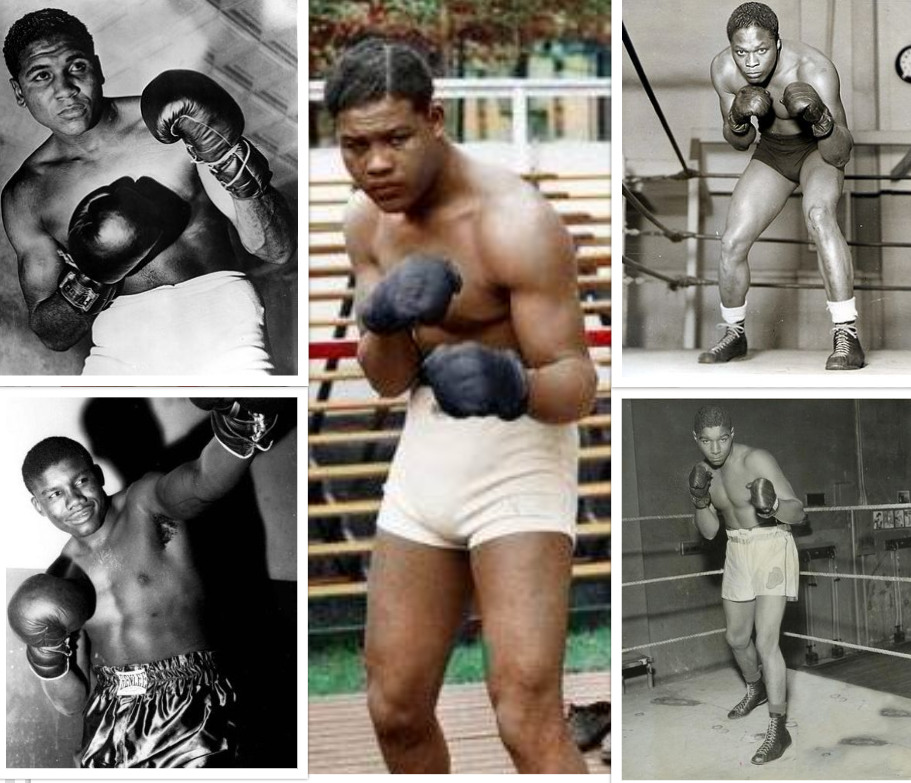

This is a response to a piece that I refuse to give credence to by naming the article or the writer. I was used as a source in his material, so I feel obligated to respond. This day April 12, 2025 on the 44th anniversary of Joe Louis death I want to set the record straight.
It should first be mentioned that Joe Louis fought main events from his pro debut in 1934. He came up steadily and beat his first top 10 contender in his 12th pro fight stopping Lee Ramage in 8 rounds. He climbed the rankings in 1935 becoming the top contender by the end of the year. Everything his managers John Roxborough and Julian Black did was designed to maneuver Joe to the top as quickly as possible. It should also be noted that black heavyweights who were considered threats to the title were named only Joe Louis. No one was talking about the other black heavyweights which were few and far between. It should also be noted that Joe Louis did fight other black fighters in his career including Willie Davis, Andy Walker, Johnny Davis, Omelio Agramonte, John Henry Lewis, Jersey Joe Walcott, Ezzard Charles and Jimmy Bivins.
Let us not forget this was the era of Jim Crow and opportunities for black contenders were limited. Louis's path to the title was far from guaranteed. There had only been one black heavyweight champion to this point, Jack Johnson. He was so reviled by the white men of that time that there was a gentleman's agreement among boxing promoters that there would never again be a black heavyweight champion. In order to be considered, his primary path was to beat the top white fighters and clean out the division, so there would be no choice other than to give him a shot at the title.
There is another factor to consider and that is the rise of fascism and Adolph Hitler in Germany. In 1936 when the previously unbeaten Louis lost to Germany’s Max Schmeling the powers that be were very worried that Schmeling would beat reigning champion James J. Braddock and take the title back to Nazi Germany where it would remain unchallenged for the duration of the war. All of America's power brokers refused to let that happen including promoter Mike Jacobs, a Jew. Louis career was then geared to a title shot against Braddock first. Louis had no control over this. This was all politics.
Even Louis first title defense was political. Tommy Farr was the British champion. Schmeling’s camp was trying to arrange a match against Farr so Max could claim he had beaten both the top American and British fighters and was the true champion. Mike Jacobs rushed to make that fight first. After besting Farr, Louis focus was then on a rematch against Schmeling so he could avenge his only defeat.
Now let's look at the heavyweight rankings and records of those Louis supposedly avoided.
Joe Louis had risen to the # 1 contender spot by the end of 1935. No other black fighter was rated in the top ten in '35. The highest rated black heavyweight of 1936, other than Louis was Jack Trammell who was rated as high as # 4. Louis lost to Schmeling in 36 and therefore had to be rebuilt. In the year they most likely could have met in '37, Trammell lost twice to Tiger Jack Fox, once by ko. He also lost to Patsy Perroni who won by "a wide margin" over Trammell. Perroni was a fighter Louis had already beaten. Clearly Louis did not avoid Trammell.
Those most frequently mentioned black opponents that Louis didn’t face are Roscoe Toles, Lem Franklin, Turkey Thompson and Jimmy Bivins, the latter - Bivins -became the top contender in 1942 when Louis was inducted into the armed forces. Louis fought only two times for purses he donated to the Army and Navy relief funds in early '42, when he was already enlisted in the Army. He was then unable to fight until 46 when the war was over, except for exhibitions. Louis cannot be criticized for not meeting Bivins, it was not his fault that the Second World War took place. An old balding Louis did fight Bivins later and still beat him.
There were no calls for Louis to fight the men he is now criticized of avoiding in era, like there was with Jack Johnson who was accused of avoiding the top black fighters of his day. Promoter Hugh McIntosh offered lots of money at various times for Johnson to defend against his top black challengers. No one was offering big purses for Louis to fight the few black heavyweights during his era because there was no Sam Langford, Joe Jeannette or Sam McVea quality of heavyweight that Louis "ducked."
Some boxing observers rely solely on Boxrec for their opinions. Contrary to popular belief Boxrec is not the Bible of boxing. There are far too many Boxrec click and blabber boys who don’t do any real research.
Reading in Nat Fleischer’s “An Illustrated History of Boxing” 6th edition, page 128, Fleischer who lived through the era, wrote, “Among his (Louis) victims were many of the better class of heavyweights, including Stanley Poreda, Charley Massera, Patsy Perroni, Natie Brown, Roy Lazer, Roscoe Toles….” The fact is Joe Louis did fight Roscoe Toles, one of the men the Boxrec clickers most commonly mention.
" The fact is Joe Louis did fight Roscoe Toles...and knocked him out "
Respected historian and record researcher Tracy Callis lists Roscoe Toles on his record posted on the old Cyberboxingzone web site. This agrees with Fleischer. The Ring Record book I have (1981) gives the following:
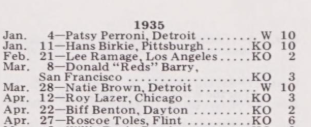
We can see the Toles is listed as an opponent of Joe Louis in 1935. That’s 3 legit sources disagreeing with Boxrec. The Boxrec critics don’t know of this fight because they don’t investigate any further than a single click of their mouse.
Louis and Toles did fight. The only question is was it a fight that belongs on his record as Fleischer, Callis and others report? Or was it an exhibition as Boxrec claims on Louis bio? Louis himself states in his auto-biography that these are real fights. He also received a portion of the gate which doesn't occur in exhibitions. The Roscoe fight was always listed in the Ring record book until 1983. Fightfax also listed it in the beginning and then had a change of opinion.
This Advertisement for the fight (below) makes no mention of it being an "exhibition."
This article for the fight also makes no mention of it being an exhibition either.
The following article may be what caused the controversy.
However one regards this discrepancy, Louis did box Roscoe Toles and beat him easily. Louis did not “duck” him in any way.
Turkey Thompson did not appear in the ratings until 1941. During '41 Thompson lost twice to Bob Pastor. Thompson also had a draw with Abe Simon in October 41. He was never in line for a title shot until 1942 at the earliest.
Lem Franklin was never in line for a title shot at Joe Louis, and I'll tell you why. The issue is one of timing. In '39 Franklin had lost a decision to Eddie Simms whom Louis had decimated in one round. Franklin did not appear in the ratings until later in 1940. In ‘41 the match that was being talked about in the press was Louis against Billy Conn who was the # 1 contender. No one was talking about a match against Franklin. Lem didn't really make a name for himself until '41 with some good wins over Simms in a rematch, Bivins, Curtis Sheppard, and Abe Simon over the course of the year. He would have been in line for a title shot in 42.
By the end of 1941 there were few, if any, boxing pundits calling for Louis to fight Lem Franklin in the press. Then came Pearl Harbor. Joe Louis enlisted in the Army in January effectively putting his boxing career on hold. He fought twice against familiar opponents working for no pay against two top 10 contenders whom he beat decisively, donating his purses to the Army and Navy Relief Funds. Meanwhile Franklin had a match against another top 10 contender in Feb that would have solidified his claim as the top contender against Bob Pastor, who had been the bane of many of the other black heavyweights of this era. Pastor stopped Franklin in the 8th. Recall that Louis had already beaten Pastor twice at this point. Franklin fought again in March and was again halted, this time in one round by Harry Bobo. Lem Franklin had been knocked out twice by March of 42. The title was frozen for the duration of the war. There would not be another match for the heavyweight title until 1946.
The only other black heavyweight worth mentioning is Elmer Ray who was one of the top black fighters during the War period. As Buddy Gibbs wrote:
"Elmer Ray and Louis sparred in 1946 and in 1949 they fought 3 exhibitions against each other... In the 2nd meeting Louis rocked Ray so badly in the 3rd round that the referee stepped between them so Ray could recover and finish out the exhibition for the fans. In the 3rd fight Elmer was knocked out and suffered a pretty bad concussion and it crushed his spirits (by his own account). He had a great string of wins and KOs during his rise but mostly against poor and selected competition. Also, for many diehards, the padded record didn't go over well. And when the opportunity surfaced for his first appearance in MSG in 1945 against Shamus O'Brien he didn't impress. His wins over Ezzard Charles and Jersey Joe Walcott didn't light the world on fire either. None of this is to knock Elmer, I'm a big fan, but he wasn't a boogeyman for Louis."
The only place the critics have to go is the questions as to why Louis didnt defend against these men when he gave opportunities to lesser fighters. Louis gave all of his top contenders title shots at appropriate times. Louis instructed his handlers to keep him busy. Roberto Duran fought a lot of over the weight non title bouts against lesser entities to stay active and keep him in fighting shape. Heavyweights don't have this luxury since there is no weight class above them. Louis did fight tune up fights in between his bouts against the top contenders. Not every bout is against a top ranked fighter, although he did fight them. The fact is the best black fighters of Louis day where not highly regarded and he either beat them, as in the case of Toles and Bivins, beat them in exhibitions like with Ray, or when they were in line for a title shot they got beaten as with Trammell or the war interfered as with Franklin, who also was beaten badly twice in early '42.
Nat Fleischer wrote that Joe Louis “barred no one.” Louis fought all the top contenders who were deserving. A few black boxers appeared briefly in the ratings and quickly disappeared. There were no other elite black heavyweights other than Louis himself in this period. No one was clamoring for him to defend against any of those men. No one asked him, "Hey Joe, why didn’t you fight these other black boxers?" On the contrary, when Joe Louis retired in ’49 Fleischer wrote that he “had no more worlds to conquer.”
To suggest that Louis not facing the available black heavyweights of his era is somehow disgraceful is not only entirely revisionist and absurd but also demonstrates a complete lack of understanding of boxing history and the period in which he fought.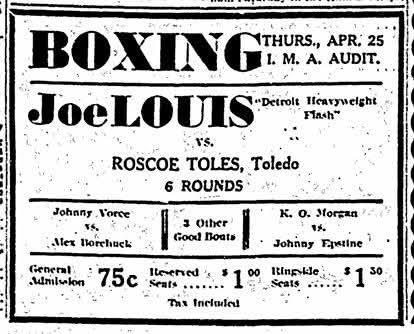

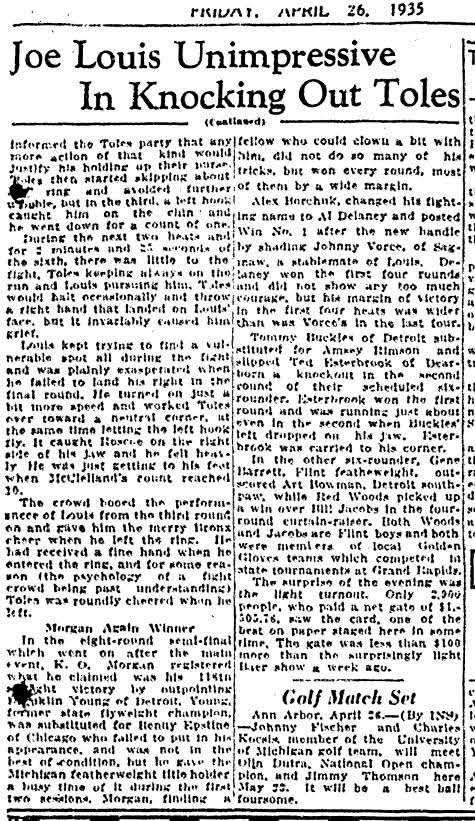
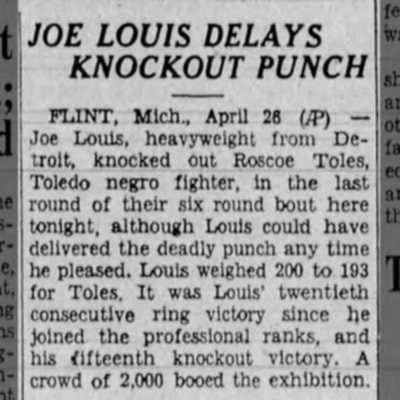
It states it was Louis's 20th professional fight and 15th knockout, while also referring to it as an exhibition at the article's conclusion. But did they call it that because the fight was slow, and the crowd reportedly booed until Louis flattened Toles with a single punch in the 6th round? It was not unusual in that era to call a match that didnt meet expectations an exhibition. In other words it seemed to be a glorified sparring session the way the bout went until Louis ended things.